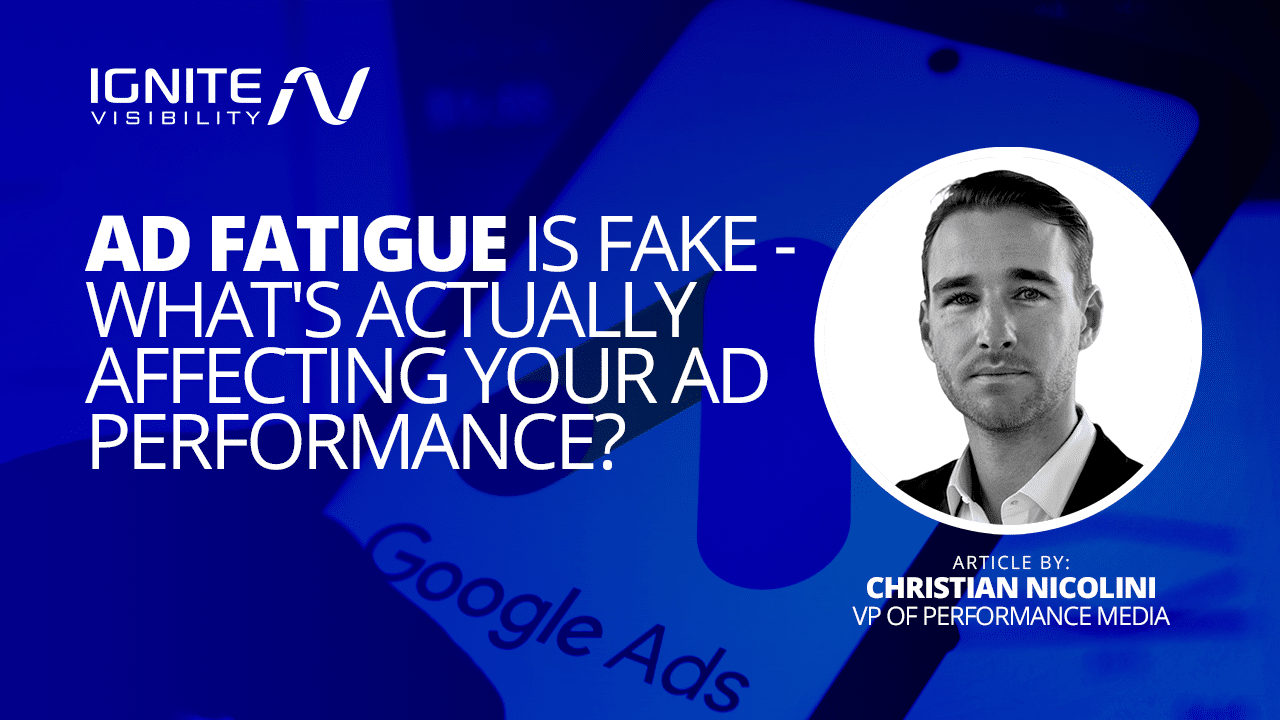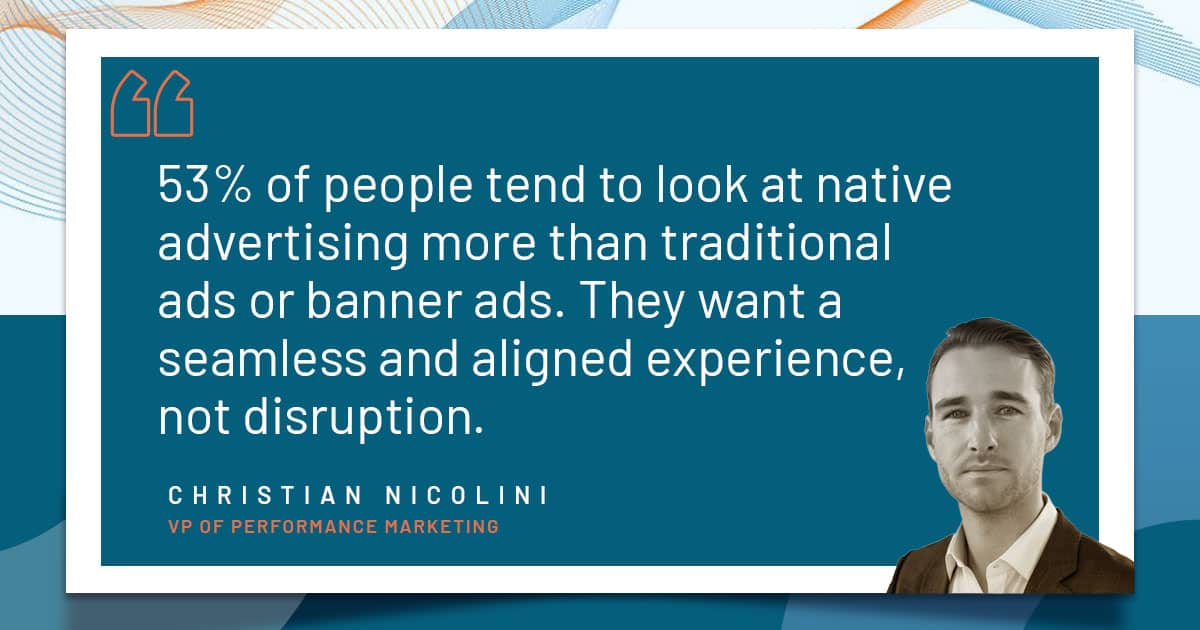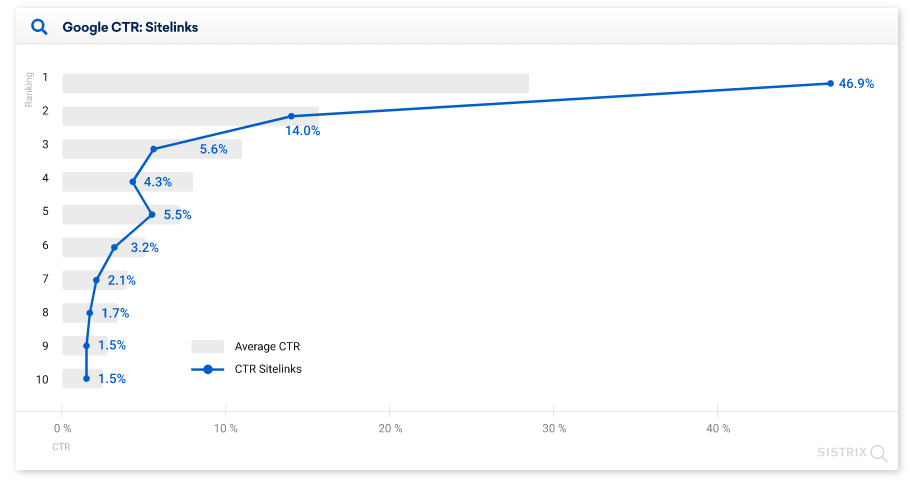
In the world of digital marketing, where Facebook, TikTok, and YouTube reign supreme, advertisers often point fingers at “ad fatigue” as the culprit for underperforming campaigns.
But, is ad fatigue the real issue?
With over a decade of experience and having managed millions in media spend, I’m sharing my take on why your ads aren’t performing.
Our Expert Insights on Ad Fatigue
However, as Ignite’s VP of Performance Media Christian Nicolini, I’ve realized that ad fatigue isn’t real. I’ve seen many advertisers rush to blame “advertising fatigue” as the main source of their problems in recent years, but is it the core issue behind poor performance? Our team, which has managed more than $500 million in media spend in the last decade, is here to shed some light.
So, what is ad fatigue, exactly? Here’s how people define it: Ad fatigue is what happens when your content feels so repetitive that your audience grows tired of it.
Here’s my take on the subject: People aren’t experiencing advertising or marketing fatigue, per se. Recent stats show that people, especially younger generations, like seeing personalized ads, with 81% of Gen Zers stating they enjoy these types of ads while 57% of Millennials stated the same.
What people don’t want to see are disruptive ads that compromise the user experience. For instance, 53% of people tend to look at native advertising more than traditional ads or banner ads.
It comes down to a seamless and aligned experience vs. disruption. What may seem like ad fatigue at first could simply be a failure to push ads that feel less like ads and more like direct, personalized, and organic messages to potential customers. Your ads may be too loud, inauthentic, and attention-getting, which could deter rather than attract audiences, no matter how much you try to stand out on each platform.
So, while advertising fatigue can play a role in audience disconnect, you might simply not be catering to the user experience with your ads at all.
The truth is, if you’re one of the brands contributing to the over $173 billion spent on social advertising in 2022 alone, you can’t afford to fall victim to poor ad performance. If you do, you need to work quickly to find a way to breathe new life into your campaign and ensure your ads establish a real connection with users on every relevant platform.

Christian Nicolini – Ad Fatigue
Develop Ads That Work For Designated Platforms
If you think ad, marketing, or general content fatigue is hurting your ad campaigns, I contend that this might not be the case. I argue that many advertisers develop flashy ads that might not mesh with a particular platform to stand apart, but it’s often best to create a seamless ad experience that works best on the designated platform.
Understand that platforms like Facebook, TikTok, and YouTube deliver a user-centric experience—they want to keep users consistently engaged and happy with their experience. As such, they won’t push irrelevant or disruptive ads that simply serve to stand out from competitors.
To get the best results on each social media site or other platform you target, you need to engineer your ads to meet users’ needs at various stages of the buyer’s journey.
The content should also blend in with the respective experience, engaging users without turning them away for being too loud and obnoxious.
I recommend optimizing your ad campaign framework and getting things right in your ad development early on, which can help you avoid issues preventing your ads from resonating.
Creating Ads That Resonate to Avoid Ad Fatigue
Want to create ads that truly work? Here are a couple of key tips I recommend following to guide your efforts:
Blend In to Stand Out
First things first, your ads should work with the specific platform you’re targeting. If your ad blatantly yells “I’m an ad!” you’re not going to build a strong connection with any audience.
For instance, don’t go too sales-y and flashy with Facebook; use high-quality images or videos that match your audience’s interests and fit right in with the rest of their feed.
Meanwhile, TikTok ads might be a bit more entertaining. Consider using native tools like TikTok’s Video Editor for content creation, which can help you add native effects, music, text, and other features that naturally appear in regular content.
In the process, you can create video ads that feel like a user-created video in each person’s feed.
Using native ad creation tools is a great way to figure out what will work best in your ads to build relationships with users.
Another technique I suggest you try here is layered audience targeting, which entails using different types of ads to reach different audiences based on their behavior and goals.
An example of this type of targeting could include developing display ads for in-market audiences, which consist of people actively seeking the types of offerings you provide. You could also target custom affinity audiences according to interests and relevant websites where your ads will resonate most.
Choose Key Metrics and Monitor Them
Another main tip I can give here applies to the metrics you use to track your campaigns, including conversion and exposure metrics.
Specifically, try to develop ads that can keep a consistent click-through rate (CTR) within a range of 5%, regardless of whether you scale your budget between $100 and $1,000 every day.
You should also monitor exposure frequency to see how often your ads are getting in front of target audiences.
Tracking these and other relevant metrics based on your goals will help you figure out whether you’re hitting your goals, or it’s time for a new strategy.
Why Do These Factors Matter?
Blending your ads in with each platform and monitoring metrics offer two main advantages:
Optimized User Experience
If you can blend your ads in with their corresponding platform’s native content, this will go a long way in boosting the user experience. People will see content that fits into their regular feeds, and they won’t be quick to avoid ads that look more like the everyday content they encounter. For example, audiences will be more inclined to engage with a fun and entertaining ad on TikTok that uses TikTok content features, while a professional ad with a high-quality image is more likely to work for a Sponsored Content ad on LinkedIn.
Improved Overall Ad Performance
By tracking CTR and ad frequency, you can determine if you need to make any adjustments to your campaigns to improve performance. If you notice that your ads have consistent frequency and high CTRs, this will indicate that your ads are doing well.
3 Signs Your Ads Aren’t Working
1. Lower Click-Through Rates
Your click-through rate, or CTR, is the number of clicks each advertisement generates. This correlates to the number of people who took an action after seeing your content. When it comes to digital marketing, your CTR is one of the most important metrics to pay attention to.
If your ads usually have a 10-15% CTR but you start to see rates closer to 5-7%, you need to recognize that you have a content strategy problem. A decline in CTR means that your content is not compelling your audience to take the next step in your sales funnel.
2. Lower Engagement Rates
Engagement rates are another really good indicator of how well your content is performing. Content that garners a lot of likes, comments, or shares is being consumed. If someone cares enough to comment on your content, they care enough to notice it.
Not only does engagement go a long way with your existing consumer base, but it’s also key to building your brand’s authority with new audiences. When consumers see solid social proof, they’re more likely to enter your sales funnel and take the next step toward becoming a paying customer. Without that engagement to help push them, you may not secure that new consumer.
When your engagement rates start to drop, it’s an indication that people aren’t being motivated to engage with your brand organically.
3. Lower Impressions
Whether it’s for paid or organic media, social media algorithms work the same way. If people don’t interact with your content, it won’t be shown as much.
To make sure this isn’t happening to you, monitor the number of impressions your content is receiving. If you start to see this metric go down, you can safely assume that your audience is suffering from advertising fatigue. Take this as a sign for you to start making some adjustments.
6 Simple Tweaks to Improve Your Ads
Here are some things you can do if you start to notice that your consumers are experiencing ad fatigue.
1. Update the Background of Your Display Ads
Changing your background is a pretty quick and efficient fix. Just a simple background color or font color change can make your content look and feel new in the eyes of your consumer.
2. Update Your Visuals
When was the last time you updated your visuals? If your current ad features a pink water bottle but doesn’t seem to be performing well, switch out the pink water bottle for a white one. A simple graphic change could be all you need to wake up your audience.
Changing your fonts or adjusting your ad layout also helps. You can also consider moving from a static graphic to video content to boost engagement and avoid ad fatigue.
3. Use Ad Customizers
Ad customizers work well and for good reason. When you get your ad in front of the right people at exactly the right time, you’re likely to experience a higher CTR. Use customizers to tailor your content to specific locations, unique users, or limited time frames to increase your odds.

4. Frequently Rotate Your Ads
Even if you’re promoting the same event or product, create various ads with different graphics, updated copy, and a mix of graphics and video content to rotate throughout your campaign. You may be promoting the same thing but your varying ads will make it appear new to your audience.
5. Continuously Update Your Keyword Research
Keywords are great—if you’re using them correctly. What your preferred audiences are searching for changes every day, so make sure you revisit your keyword research often throughout your campaign. Updating your keywords can also help you reach new audiences that you may not have considered before.
6. Rewrite Your Ad Copy
Sometimes rewriting your ad copy is exactly what you need to refresh your ads Figure out words to avoid and craft new ways to get your point across.
It’s always a good idea to refresh your ad copy around the same time that you’re updating your keyword research. Make sure your copy includes the relevant keywords to increase your chances of exposure.
Develop a System for Testing Your Ad Campaigns
A large part of battling ad fatigue simply means being hands-on with your campaign. Digital marketing is not a “set it and forget it” type of business. You have to monitor your progress consistently, making the appropriate adjustments along the way.
To be sure you’re doing this correctly, develop a system for testing and measuring your campaigns. Perform A/B tests and monitor your KPIs. Develop a system for testing that produces reliable results.
There may be other critical factors at play that are causing poor ad campaign performance. It’s not enough to answer “what is ad fatigue?” or “how can you avoid fatigue?” You must also look deeper into other performance issues, including a misunderstanding of platform priorities and disruptive ads.
If you feel as though your content isn’t getting the same traction it used to, it is very possible that your audience simply finds your content disengaging. Try some of these tips to wake them up and start reaching your goals again.
By learning what types of ad content work best for each of your target platforms and monitoring performance, you can improve your metrics and achieve your advertising goals more effectively.
Avoid Ad Fatigue! Let Ignite Help You With Your Ad Campaigns
Need some help with your ad campaigns? Turn to Ignite Visibility to help you get the most from your ad content.
Here at Ignite, you can:
- Discover an agency that has mastered the intricacies of each platform.
- Collaborate on developing a suite of creative assets specifically designed for peak performance on their respective platforms.
- Explore our approach to crafting unique creative solutions that truly work for you.
If you like this idea, connect with the team at Ignite Visibility today and get the results you want from your ad campaigns!


